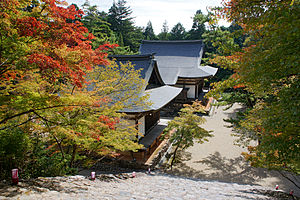Jingo-ji
| Jingo-ji 神護寺 |
|
|---|---|

Godai-dō (left) and Bishamon-dō (right)
|
|
| Basic information | |
| Location | 5 Takao-chō, Ume-ga-hata, Ukyō-ku Kyoto, Kyoto Prefecture |
| Affiliation | Shingon Buddhism |
| Country | Japan |
| Completed | 824 |
Jingo-ji (神護寺?) is a Buddhist temple in Kyoto. It stands on Mount Takao to the northwest of the center of the city. The temple adheres to Shingon Buddhism. Its gohonzon is a statue of Bhaisajyaguru (Yakushi Nyoōrai), the Buddha of Healing or "Medicine Buddha".
The temple was established in the year 824, as a merger of two private temples founded earlier by Wake no Kiyomaro. They were the Jingan-ji (神願寺) in Kiyomaro's home province and the Takaosan-ji (高雄山寺).
Jingo-ji holds sixteen National Treasures of Japan. They include the honzon and other statues. Another treasure is a list written by Kūkai in 812 called the "Name List of Abhisheka [Initiates]" (灌頂歴名 kanjōrekimyō?) and displays some of Kukai's talent for calligraphy. This list contains people and deities in 812 who underwent the abhisheka at Takaosan-ji presided by Kūkai.
The Buddhist Sutra “Bimashōkyō”, translated by Guṇabhadra, was handed down at the temple. It is "one of the a volume from the Issaikyō (a Buddhist corpus), commonly known as Jingo-ji kyō ... The corpus originally consisted of more than 5,400 volumes in total, but only 2,317 still remain as the rest were scattered outside the temple."
...
Wikipedia
